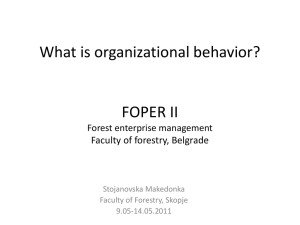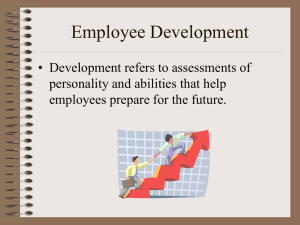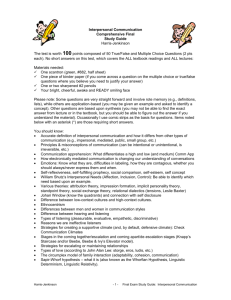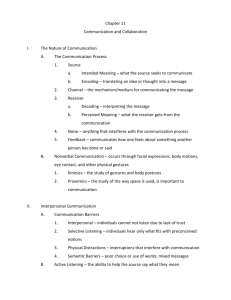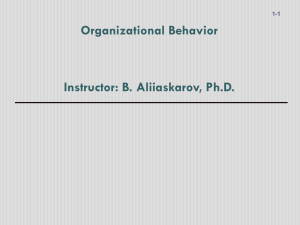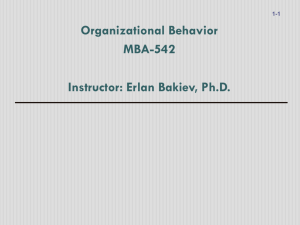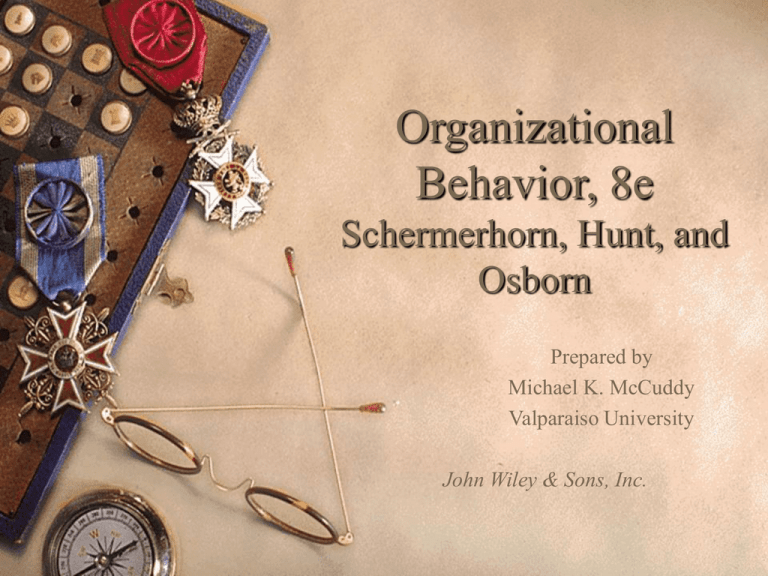
Organizational
Behavior, 8e
Schermerhorn, Hunt, and
Osborn
Prepared by
Michael K. McCuddy
Valparaiso University
John Wiley & Sons, Inc.
COPYRIGHT
Copyright 2003 © John Wiley & Sons, Inc. All rights reserved.
Reproduction or translation of this work beyond that permitted in Section
117 of the 1976 United States Copyright Act without the express written
permission of the copyright owner is unlawful. Request for further
information should be addressed to the Permissions Department, John Wiley
& Sons, Inc. The purchaser may make back-up copies for his/her own use
only and not for distribution or resale. The Publisher assumes no
responsibility for errors, omissions, or damages, caused by the use of these
programs or from the use of the information contained herein.
Organizational Behavior: Chapter 16
2
Chapter 16
Information and Communication
Study questions.
– What is the nature of the communication
process?
– What are the essentials of interpersonal
communication?
– What barriers interfere with effective
communication?
Organizational Behavior: Chapter 16
3
Chapter 16
Information and Communication
Study questions — cont.
– What is organizational communication?
– What forces influence communication in the
high performance workplace?
Organizational Behavior: Chapter 16
4
What is the nature of the
communication process?
The communication process.
– A process of sending and receiving messages
with attached meanings.
Organizational Behavior: Chapter 16
5
What is the nature of the
communication process?
The communication process.
– Source — encodes an intended meaning into a
message.
– Receiver — decodes the message into
perceived meaning.
– Communication channel — the means by
which the message is transmitted.
Organizational Behavior: Chapter 16
6
What is the nature of the
communication process?
The communication process — cont.
– Feedback — the receiver transmits a message
back to the sender.
– Noise — any interference with the
transmission of the message.
Organizational Behavior: Chapter 16
7
What is the nature of the
communication process?
Feedback and communication.
– Feedback is the process through which the
receiver communicates with the sender by
returning another message.
– Giving feedback often is associated with one
or more persons communicating an evaluation
of what another person has said or done.
– 360-degree feedback.
Organizational Behavior: Chapter 16
8
What are the essentials of
interpersonal communication?
Effective and efficient communication.
– Effective communication.
• The accuracy of communication.
– Efficient communication.
• The cost of communication.
– Effectiveness does not guarantee efficiency or
vice versa.
Organizational Behavior: Chapter 16
9
What are the essentials of
interpersonal communication?
Nonverbal communication.
– Takes place through:
• Facial expressions
• Body position.
• Eye contact.
• Other physical gestures.
– Nonverbals give clues to what a person is
really thinking.
Organizational Behavior: Chapter 16
10
What are the essentials of
interpersonal communication?
Two important branches of nonverbal
communication.
– Kinesics.
• The study of gestures and body postures.
– Proxemics.
• The study of the way space is utilized.
Organizational Behavior: Chapter 16
11
What are the essentials of
interpersonal communication?
Active listening.
– Ability to listen well is a distinct asset.
– Too often people emphasize the telling side
and neglect the listening side of the
communication process.
– Active listening.
• The ability to help the source of a message say
what he or she really means.
Organizational Behavior: Chapter 16
12
What barriers interfere with
effective communication?
Common sources of noise in interpersonal
communication.
–
–
–
–
–
–
Physical distractions.
Semantic problems.
Mixed messages.
Cultural differences.
Absence of feedback.
Status effects.
Organizational Behavior: Chapter 16
13
What barriers interfere with
effective communication?
Physical distractions.
– Any aspect of the physical setting in which
communication takes place.
– Can interfere with communication
effectiveness.
Organizational Behavior: Chapter 16
14
What barriers interfere with
effective communication?
Semantic problems.
– Involves a poor choice or use of words.
– Use the KISS principle of communication.
• “Keep it short and simple.”
Organizational Behavior: Chapter 16
15
What barriers interfere with
effective communication?
Mixed messages.
– Occur when a person’s words communicate
one thing while body language communicates
another.
– Body language adds important insights in
face-to-face meetings.
Organizational Behavior: Chapter 16
16
What barriers interfere with
effective communication?
Cultural differences.
– Ethnocentrism.
• The tendency to believe that one’s culture and it
values are superiors to those of others.
• Often linked to an unwillingness to understand
alternative points of view.
– Other cross-cultural communication
challenges.
• Language differences.
• Use of gestures.
Organizational Behavior: Chapter 16
17
What barriers interfere with
effective communication?
Absence of feedback.
– As compared to one-way communication, two-
way communication is:
• More accurate.
• More effective.
• More costly.
• More time consuming.
Organizational Behavior: Chapter 16
18
What barriers interfere with
effective communication?
Status effects.
– Status differences create potential communication
barriers.
• Managers may do more telling than listening.
• Subordinates may filter information.
– MUM effect
• Occurs when people are reluctant to transmit bad news.
– Management by wandering around (MBWA).
• Getting out of the office to directly communicate with others.
Organizational Behavior: Chapter 16
19
What is organizational communication?
Organizational communication is the
specific process through which information
moves and is exchanged throughout an
organization.
Information flows:
– Through formal and informal structures.
– Downward, upward, and laterally.
Organizational Behavior: Chapter 16
20
What is organizational communication?
Channel richness.
– The capacity of a communication channel to convey
information effectively.
– Richest channels — face-to-face communication.
– Moderately rich channels — telephone, electronic chat
rooms, E-mail, written memos, and letters.
– Leanest channels — posted notices and bulletins.
Organizational Behavior: Chapter 16
21
What is organizational communication?
Formal and informal communication
channels.
– Formal channels follow the chain of command
established by the hierarchy of authority.
– Informal channels do not adhere to the
hierarchy of authority.
• The grapevine is an informal channel through
which rumors and unofficial information pass.
Organizational Behavior: Chapter 16
22
What is organizational communication?
Communication flows and directions.
– Downward communication.
– Upward communication.
– Lateral communication.
Organizational Behavior: Chapter 16
23
What is organizational communication?
Downward communication.
– The flow of information follows the chain of
command from top to bottom.
– Downward communication informs lower level
personnel about the higher level managers’:
• Strategies.
• Objectives.
• Instructions.
• Policies.
• Feedback.
Organizational Behavior: Chapter 16
24
What is organizational communication?
Upward communication.
– The flow of information from lower to higher levels of
the organization.
– Upward communication informs higher level
personnel about lower level workers’:
• Problems.
• Results.
• Suggestions.
• Questions.
• Needs.
Organizational Behavior: Chapter 16
25
What is organizational communication?
Lateral communication.
– The flow of information across persons or
work units at the same hierarchical level.
– Lateral communication enables persons and
work units to coordinate:
•
•
•
•
Problems.
Needs.
Advice.
Feedback.
Organizational Behavior: Chapter 16
26
What is organizational communication?
Lateral communication — cont.
– Very important in high performance
organizations.
• Serving external customers.
• Serving internal customers.
– Organizational ecology.
• The study of how building design may influence
communication and productivity by improving
lateral communication.
Organizational Behavior: Chapter 16
27
What is organizational communication?
Types of communication networks.
– Decentralized communication network.
– Centralized communication network.
– Restricted communication network.
Organizational Behavior: Chapter 16
28
What is organizational communication?
Decentralized communication network.
– All group members communicate directly and
share information with one another.
– Sometimes called an all-channel or star
network.
– Involve interacting groups.
Organizational Behavior: Chapter 16
29
What is organizational communication?
Centralized communication network.
– Information flows to a central person and is
redistributed.
– Sometimes called a wheel or chain network.
– Involve coacting groups.
Organizational Behavior: Chapter 16
30
What is organizational communication?
Restricted communication network.
– Limited and possibly biased communication
due to polarized subgroups contesting each
other’s positions and maintaining sometimes
antagonistic relationships.
– Involve counteracting groups.
Organizational Behavior: Chapter 16
31
What forces influence communication
in the high performance workplace?
The explosion of new communication
technologies is one of the greatest
contemporary challenges.
Effective communication skills are
essential for career success.
Everyone must stay current on information
technologies and organizational
communication issues.
Organizational Behavior: Chapter 16
32
What forces influence communication
in the high performance workplace?
Advances in information technologies enable
organizations to:
– Distribute information much faster.
– Make more information available.
– Allow broader and more immediate access to
information.
– Encourage participation in the sharing and use of
information.
– Integrate systems and functions, and use information
to link with the environment.
Organizational Behavior: Chapter 16
33
What forces influence communication
in the high performance workplace?
Potential disadvantages of electronic
communications.
– Technologies are impersonal.
– Nonverbal communication is removed from
situation.
– Can unduly influence the emotional aspects of
communication.
– Information overload.
Organizational Behavior: Chapter 16
34
What forces influence communication
in the high performance workplace?
Complex social context.
– Mean and women are socialized into different
communication styles.
• Women are socialized to be more sensitive to
interpersonal relationships in communication.
• Men are socialized to be competitive, aggressive,
and individualistic, which may cause
communication problems.
Organizational Behavior: Chapter 16
35
What forces influence communication
in the high performance workplace?
Complex social context — cont.
– Privacy of employee communications and
electronic eavesdropping
• Progressive organizations are developing internal
privacy policies.
• Is gaining the attention of some legislators.
– Political correctness of communications in the
workplace.
• Eliminates communication overtones of intolerance
and insensitivity.
Organizational Behavior: Chapter 16
36


